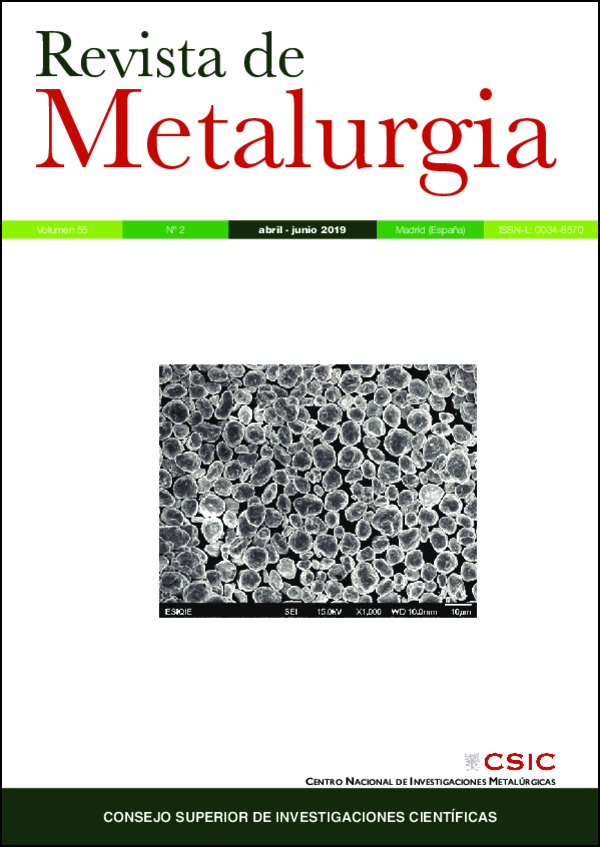Statistical analysis of the coating thickness of duplex protection systems during the accelerated climatic test of humidity and controlled temperature
DOI:
https://doi.org/10.3989/revmetalm.146Keywords:
Duplex protection, Statistics, Test, ThicknessAbstract
Steel is a very versatile metallic material and widely used in modern life. Unfortunately, this material is prone to the phenomenon of corrosion and over time, can contribute to the failure of the product. In order to minimize this process, different types of coatings are used, due to their efficiency, economy and ease of application. The degradation of the film applied to steel by atmospheric agents is the result of the combination of various environmental factors, due to the highly destructive cyclic variations. The present work intends to determine the existence of significant statistical differences in the thickness distribution of coating in duplex systems (Fe/Zn/Paint), before and after conducting the humidity and temperature test with condensation in a constant atmosphere, from different tests carried out in the Statgraphics Centurion software. The influence of the preset conditions on the coating thickness before and after the test was demonstrated was demonstrated. These values were found in a suitable interval to guarantee the resistance to corrosion, not showing visible deterioration in the surface of the analyzed specimens.
Downloads
References
Castañeda, A., Rivero, C., Corvo, F. (2012). Evaluación de sistemas de protección contra la corrosión en la rehabilitación de estructuras construidas en sitios de elevada agresividad corrosiva en Cuba. Revista de la Construcción 11 (3), 49-61. https://doi.org/10.4067/S0718-915X2012000300005
CITMA (1997). Ley 81 del Medio Ambiente, 7 Stat. http://www.sld.cu/galerias/pdf/sitios/insat/ley-81-citma.pdf.
Cutipa Mamani, C.A. (2014). Planteamiento para determinar comportamientos óptimos entre sistemas de protección dúplex (Galvanizado en caliente/frío + recubrimiento) para estructuras metálicas de SE y LT. Facultad de Ingeniería de Procesos, UNSA. http://repositorio.unsa.edu.pe/handle/UNSA/2908.
ISO 2178 (2016). Non-magnetic coatings on magnetic substrates - Measurement of coating thickness - Magnetic method. International Organization for Standardization, page 37.
López, C.M., Iturralde, M.A., Claro, R., Ruiz, L., Cabrera, G.J., Molerio, L., Rodríguez, Y. (2006). Introducción al conocimiento del medio ambiente. Vol. 1, Editorial-Académica, pp. 1-32. http://aulag.aulas.rimed.cu/files/2013/11/Tabloide-Medio-Ambiente.pdf.
Marrero-Águila, R., González Prada, C., González-Ortega, L., McNeil Montañés, B. (2013). Ensayos de corrosión naturales y acelerados en sistemas de pinturas aplicados sobre acero. Tecnología Química 33 (3), 233-241.
Mina Cevallos, E. (2011). Ensayos de corrosión metálica en laboratorio y su correlación con ensayos de campo. Tesis Ing. Química (IQUIM), Escuela Politécnica Nacional Quito, Ed. QUITO/EPN.
NC-ISO 6270-2 (2017). Pinturas y barnices. Determinación de la resistencia a la humedad. Parte 2: Condensación (exposición en cabina con depósito de agua caliente).
NC-ISO-4628-2 (2018). Pinturas y barnices-Evaluación de la degradación de los recubrimientos de pintura. Designación de la intensidad, cantidad y tamaño de los tipos más comunes de defectos-Parte 2: Designación del grado de ampollamiento.
NC-ISO-4628-3 (2018). Pinturas y barnices - Evaluación de la degradación de los recubrimientos - Designación de la intensidad, cantidad y tamaño de los tipos más comunes de defectos - Parte 3: Evaluación del grado de oxidación.
NC-ISO-4628-4 (2018). Pinturas y barnices - Evaluación de la degradación de los recubrimientos - Designación de la intensidad, cantidad y tamaño de los tipos más comunes de defectos - Parte 4: Evaluación del grado de agrietamiento.
NC-ISO-4628-5 (2018). Pinturas y barnices - Evaluación de la degradación de los recubrimientos - Designación de la intensidad, cantidad y tamaño de los tipos más comunes de defectos - Parte 5: Evaluación del grado de descamación.
NC-ISO-4628-6 (2018). Pinturas y barnices - Evaluación de la degradación de los recubrimientos - Designación de la intensidad, cantidad y tamaño de los tipos más comunes de defectos - Parte 6: evaluación del grado de enyesado por el método de la cinta.
Simancas Peco, J. (1992). Estudio de distintas variables con influencia en el comportamiento en la atmósfera de los recubrimientos anticorrosivos aplicados sobre el acero. Tesis Doctoral, Universidad Complutense de Madrid, Madrid.
Simancas, J., Morcillo, M. (1998). Factores condicionantes de la durabilidad de los sistemas de pinturas anticorrosivas sobre acero en exposiciones atmosféricas. Rev. Metal. 34 (Extra), 132-136. https://doi.org/10.3989/revmetalm.1998.v34.iExtra.725
Vásquez Rodríguez, C.A. (2013). Caracterización del comportamiento de corrosión en pruebas aceleradas para acero galvanizado y pintado. Maestría Tesis, Universidad Autónoma de Nuevo León, San Nicolás de los Garza. http://eprints.uanl.mx/id/eprint/3800.
Published
How to Cite
Issue
Section
License
Copyright (c) 2019 Consejo Superior de Investigaciones Científicas (CSIC)

This work is licensed under a Creative Commons Attribution 4.0 International License.
© CSIC. Manuscripts published in both the printed and online versions of this Journal are the property of Consejo Superior de Investigaciones Científicas, and quoting this source is a requirement for any partial or full reproduction.
All contents of this electronic edition, except where otherwise noted, are distributed under a “Creative Commons Attribution 4.0 International” (CC BY 4.0) License. You may read the basic information and the legal text of the license. The indication of the CC BY 4.0 License must be expressly stated in this way when necessary.
Self-archiving in repositories, personal webpages or similar, of any version other than the published by the Editor, is not allowed.
















